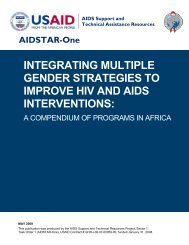HIV Stigma – Naming and Owning the Problem - ICRW
HIV Stigma – Naming and Owning the Problem - ICRW
HIV Stigma – Naming and Owning the Problem - ICRW
You also want an ePaper? Increase the reach of your titles
YUMPU automatically turns print PDFs into web optimized ePapers that Google loves.
A5. <strong>Stigma</strong> <strong>and</strong> Violence in<br />
Different Contexts<br />
Facilitator’s Note: This activity, which uses rotational brainstorming, is especially good for<br />
workshops that bring toge<strong>the</strong>r different types of health workers.<br />
Rotational brainstorming requires literacy skills, so to complete this activity with groups including<br />
TBAs you may need extra recorders (one recorder per group). At each flipchart <strong>the</strong> recorder<br />
reads out <strong>the</strong> points already written by o<strong>the</strong>r groups <strong>and</strong> asks <strong>the</strong> group to add new points.<br />
The choice of combining stigma <strong>and</strong> gender violence within a single exercise or treating <strong>the</strong>m<br />
separately is up to you. In our experience it is better to deal with <strong>the</strong>m separately when training<br />
TBAs; o<strong>the</strong>rwise it is too overwhelming. On <strong>the</strong> o<strong>the</strong>r h<strong>and</strong>, combining <strong>the</strong> two issues in a single<br />
exercise helps bring out <strong>the</strong> close links between stigma <strong>and</strong> gender violence.<br />
During <strong>the</strong> group reports, debrief on <strong>the</strong> health facility <strong>and</strong> workplace contexts last. This provides<br />
a link to <strong>the</strong> next module on “<strong>Stigma</strong> in <strong>the</strong> Workplace.”<br />
Objectives: By <strong>the</strong> end of this session, participants will be able to:<br />
a) Identify different forms of stigma <strong>and</strong> violence that take place in different contexts; <strong>and</strong><br />
b) Work out solutions to stop stigma <strong>and</strong> gender violence.<br />
Time: 1<strong>–</strong>2 hours<br />
Materials <strong>and</strong> preparation: Put up flipchart paper on different walls of <strong>the</strong> room, with a context<br />
written on each sheet: Home, Community, Market, School, Health Facility <strong>and</strong> Workplace.<br />
■■Steps:<br />
1. ROTATIONAL BRAINSTORMING (Small Groups): Divide into six groups <strong>and</strong> assign each<br />
group to a topic. Ask each group to write down on <strong>the</strong> flipchart forms of <strong>HIV</strong> stigma <strong>and</strong><br />
gender violence that occur in <strong>the</strong>ir context. (Ask <strong>the</strong>m to start writing <strong>the</strong>ir first thoughts<br />
immediately, not st<strong>and</strong> talking for a long time without writing.) After three to four minutes shout<br />
“CHANGE” <strong>and</strong> ask groups to move to <strong>the</strong> next topic <strong>and</strong> add points. Continue until each group<br />
has contributed ideas to every context.<br />
2. REPORT BACK (Rotational): The whole group moves around <strong>the</strong> room, looking at one topic<br />
at a time. Ask one participant to read out <strong>the</strong> points quickly.<br />
Option: Ano<strong>the</strong>r way to report back is to ask each group to return to <strong>the</strong> flipchart where <strong>the</strong>y<br />
started <strong>and</strong> prepare a presentation. This would include presenting <strong>the</strong> main points <strong>and</strong> doing a<br />
drama.<br />
Chapter A: <strong>HIV</strong> <strong>Stigma</strong> <strong>–</strong> <strong>Naming</strong> <strong>and</strong> <strong>Owning</strong> <strong>the</strong> <strong>Problem</strong> n 35
















